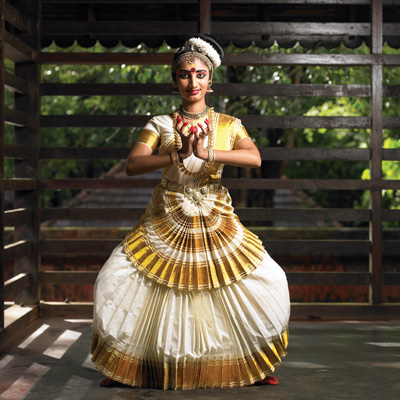
Mohiniattam
Being the most serenely beautiful state in South India, Kerala is also known for its heritage and culture. The rich culture of Kerala is depicted in the form of art and dance. The dance tradition of Kerala dates back to thousand years.
Mohiniattam - Kerala
This South Indian state of Kerala houses around 50 forms of traditional dances. Kathakali, Mohiniyattam, Thiruvathirakali, Theyyam, Chakyar Koothu, Ottamthullal, and Koodiyattam are some of the prominent dance forms of Kerala. Some of these dance forms are related to religion and are mainly performed at the time of temple festivals, harvest festival, or sowing of seeds festivals etc.
All these dance forms stand unique from each other in the way of presentation with wonderful expressions. These dance forms are performed not only by women, but they are also accompanied by men. The costumes and ornaments of the dancers are extremely colourful and attractive that add charm to the dancers as well as the dance performance.
The theme of the dance is based on a folk tale and depicts a scene from mythological stories and legends. The songs that accompany the dance is sung by the dancers themselves or by a group of musicians. The classical dance forms of Kerala are very simple, but it requires a lot of expressions.
Mohiniattam, one of the classical dance forms of Kerala has gained immense popularity among tourists worldwide. Hundreds of foreign women visit Kerala every year to practice Mohiniattam. It is one among the eight classical dances of India which has its roots in history and Hindu mythology. It is considered to be one of the oldest surviving dance forms which are performed in Kerala today.
Mohini is a mythical enchantress avatar of the Hindu god Vishnu, who is said to have appeared to seduce Asuras (demons) when the Ocean of Milk was churned. In commemoration of this great mythological event, the temple dancers of old are said to be the first to have started this dance form. And hence the dance form came to be known as Mohiniattam. The Kerala Kalamandalam takes a special interest in promoting the Mohiniyattam.
Mohiniattam has believed to have originated in the 16th century. Like all classical Indian dances, Mohiniattam has its root in the Natya Shastra which is the ancient Hindu Sanskrit text on performance arts and has a tradition over hundreds of years. This art form was very popular from 9th to the 12th century during the reign of Chera. And it is a very meaningful art form.
Mohiniattam is a blend of Bharathanatyam, Kathakali, Kuchipudi and Odissi dance. This distinctive classical dance involves graceful movements, delicate footsteps, impressive expressions, and classical Carnatic vocal music. Mohiniattam is mainly performed by a solo woman dancer who is attired in a beautiful white Kasavu sari of Kerala with golden border. Her hair is tied in a unique way and is adorned with jasmine garland that is placed in a traditional manner. The dancer is ornamented with traditional gold jewellery like bangles, chains, earrings and forehead jewellery.
In order to emphasize the facial expressions, heavy makeup is done on the face, especially on the eyes. Hence, Mohiniattam is considered as the dance of enchantress or as an enchanting dance. Mohiniattam is a visual treat which has everything to entertain its audience. It is typically a semi-classical dance form which enacts a play through dance and is accompanied by music in the Carnatic style which is extremely lyrical. Edakka, Veena, Mridangam and Indian Violin are the instruments used in the performance. The lyrics of the song are written in Manipravalam which is a mixture of Malayalam and Sanskrit.